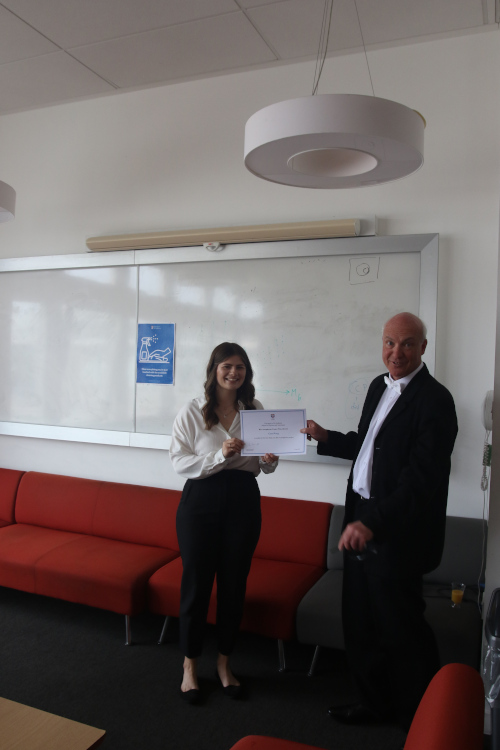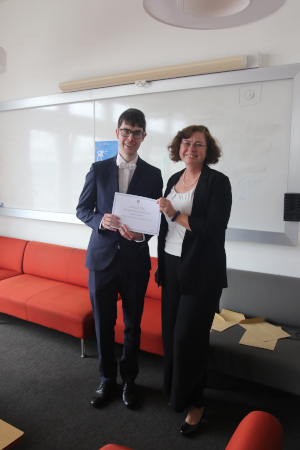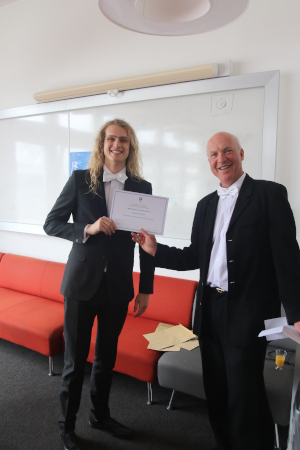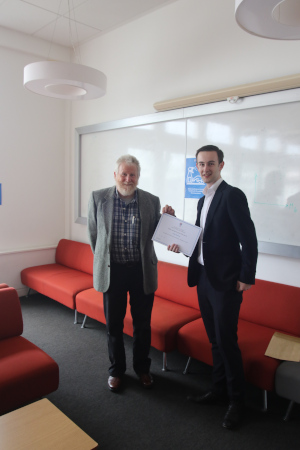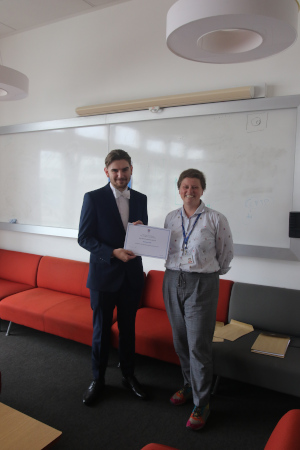Undergraduate project prize winners 2022
Students on our BSc and MPhys degree programmes undertake a major project in their final year, often working with members of our research teams. Students undertake a mix of experimental, computational, and theoretical projects, tackling problems of current research interest. They write a project report, then present their work to an examining panel, followed by a questions and answer session. The standard of the project work was extremely high year, despite continuing challenges caused by the pandemic. Several projects are awarded prizes, and the recipients attending a prize-giving ceremony, together with their guests, just before the Physics and Astronomy graduation ceremony.
Cara Wang, Richard Mills, Sol Warsop, Luke Murray and Kenny Campbell were the project prize winners. The prizes were presented by Head of School Prof Ian Bonnell. The project coordinators this session were Phil King, Martin Dominik, and Jonathan Keeling.
Cara's project was focussed on understanding metallicity in post-starburst galaxies. Her project was supervised by Vivienne Wild. Cara used smoothed-particle hydrodynamic simulations to investigate how metals are created in bursts of star formation driven by mergers of galaxies. She found that the gravitational torques that drive gas flows to the centre of the galaxy lead to an enhancement in the metallicity of the stars, regardless of the orientation of the merger, galaxy progenitor type or mass ratio of the merging galaxies. The galaxy mergers also led to very strong gradients in the stellar metallicity, with the outskirts of the remnant galaxy showing significantly less enhancement.
Kenny's project was in the area of quantum information, studying partially blind witnesses for multipartite Gaussian entanglement. He studied theoretically the design of quantum optical circuits which should allow the detection of quantum entanglement using only partial information about the system. His work could lead to new experimental tests of this phenomenon with widespread potential applications in the field of quantum technology and quantum computing. His project was supervised by Prof. Natalia Korolkova and Dr Viktor Nordgren.
Sol's project was focussed on using deep learning approaches to measure biomechanics. His project was supervised by Graham Bruce and Philip Wijesinghe. Sol has developed a new deep learning approach for measuring displacement fields from microscopy images and videos. Such observations of movements on the microscopic scale, and the quantification of complex dynamics of living materials, is important to many studies in biology and medicine. Sol’s developments have achieved rapid, video-rate processing speeds. This marks an important milestone when compared to previous methods which presently require several minutes per image frame to achieve the same quality. With this advance, we may be able to observe and quantify biodynamics over long time scales, opening new avenues for discovery. This project was supervised by Philip Wijesinghe and Graham Bruce.
Luke's project worked on probing a black hole accretion disc with a rotating searchlight beam. His project was supervised by Keith Horne.
Luke Murray built a computer model to simulate the effect on emission-line profiles of rotating x-ray beams that sweep around at the centre of a black hole accretion disc. The x-ray beams excite emission-line features that move from red to blue across the Doppler-broadened emission-line profile from gas orbiting the black hole. His model with 4 beams rotating with a 2-year period provides a good match to similar features in the line profile variations seen in the active nucleus of the Seyfert galaxy NGC 5548 obtained by the Space Telescope and Optical Reverberation Mapping (STORM) campaign.
Richard’s project was focussed on spin labelling proteins to investigate their dynamics. His project was supervised by Janet Lovett. Richard investigated the differences between small molecules called “spin labels” using electron spin resonance (ESR) spectroscopy – a type of magnetic resonance. Richard had to make proteins and add the spin labels before performing the spectroscopy. He needed to analyse the data for differences in nanosecond dynamical properties between the labels and relate this back to simulated predictions and prior knowledge about the structure of the spin labels and the protein. He was also able to use ESR to measure nanometre-scale distances between the spin labels to investigate if the dynamical properties mapped to their ability to measure structural differences in immobilized proteins. The work required a lot of care and attention-to-detail as well as an understanding and the practice of a broad range of scientific techniques. Richard’s project supervisor was Janet Lovett.
